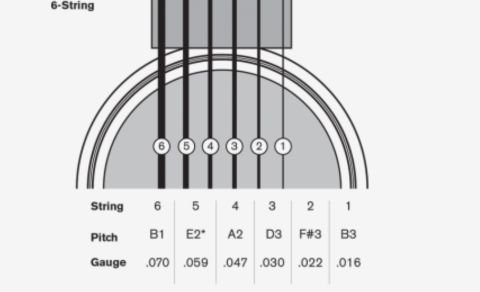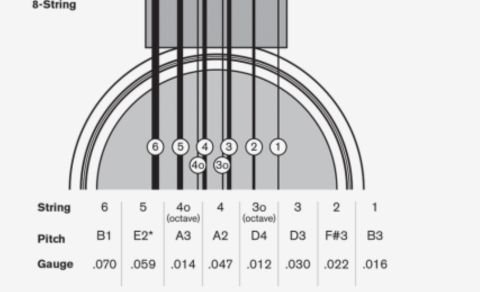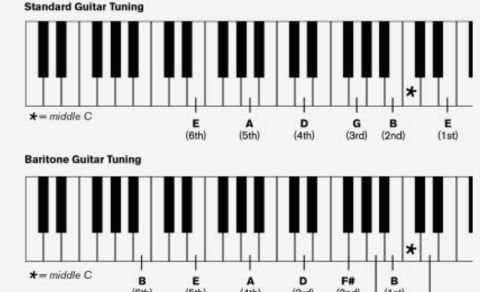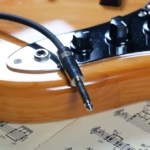What is a Baritone Guitar?
Explore the perfect baritone guitar tuning for your style. Learn about famous tunings, tips for setup, and how to get the best tone from your baritone guitar. A baritone guitar is a 6-string long-scale instrument with heavier strings guitar. It is designed to handle lower note ranges. The standard baritone is usually tuned from B to B that is a perfect fourth lower than a typical 6-string guitar. For a detailed overview of Baritone Guitar tuning methods and examples, check out Eastwood Guitars’ Baritone Guitar Guide.
Since its creation the baritone has opened up new sonic possibilities for guitarists. It is allowing them to play familiar chord and scale shapes in a deeper range. Now a day’s baritone electric guitars are used across various genres, including funk, metal, pop, and many others, expanding the limits of musical expression.
Baritone Guitar Tuning

Baritone Guitar have majorly three types of Tuning. All these are mention in this article in detail. Stay here and read carefully and understand Baritone Guitar Tuning.
- Standard Baritone Guitar Tuning
- Alternate Baritone Tunings
- Drop A Tuning (A-E-A-D-F#-B)
Standard Baritone Guitar Tuning

The most common tuning for a baritone guitar is B Standard (B-E-A-D-F#-B). It is a perfect fourth lower than standard guitar tuning (E-A-D-G-B-E).
- B Standard Tuning:
- 6th String: B (a perfect fourth below E)
- 5th String: E (same as the 6th string of a standard guitar)
- 4th String: A (same as the 5th string of a standard guitar)
- 3rd String: D (same as the 4th string of a standard guitar)
- 2nd String: F# (a perfect fourth below B)
- 1st String: B (a perfect fourth below E)
This tuning provide you to play the baritone guitar much like a standard guitar but with a deeper, more echoing sound. It holds the same relative break between the strings as a standard guitar. So you can use the same chord shapes and scale patterns though they’ll sound lower.
Alternate Baritone guitar Tunings
Baritone guitars are versatile and can handle various tunings depending on your needs and preferences. Here are a few common alternate tunings:
A Standard Tuning (A-D-G-C-E-A)
A Standard is tuned a perfect fifth below standard guitar tuning, even lower than B standard. This tuning is often used in heavier genres like metal, where even deeper and more powerful sounds are desired.
- 6th String: A
- 5th String: D
- 4th String: G
- 3rd String: C
- 2nd String: E
- 1st String: A
Drop A Tuning (A-E-A-D-F#-B)
This tuning is like B standard. The difference is the low B string is tuned down to A it is giving a deep heavy sound for powerful riffs and chords. It is commonly used in metal and heavy rock because it provide you play lower notes without changing the basic chord shapes.
- 6th String: A
- 5th String: E
- 4th String: A
- 3rd String: D
- 2nd String: F#
- 1st String: B
C Standard Tuning (C-F-A#-D#-G-C)
This is a famous tuning for baritone guitars that want a mid-range low sound. It is commonly used in doom metal, sludge, and other genres. That require a heavy, deep tone but not as low as A or B standard.
- 6th String: C
- 5th String: F
- 4th String: A#
- 3rd String: D#
- 2nd String: G
- 1st String: C
Why Use a Baritone Guitar?

The baritone-tuned guitar was relatively rare until 1956 when the Danelectro Company introduced an electric baritone model. This instrument gained some recognition in surf music and film scores, especially in “spaghetti Westerns.” A notable playing technique associated with the baritone guitar is “tic-tac bass,” where a muted baritone guitar doubles the lines played by a bass guitar or double bass. This method is widely used in country music.
Baritone guitars offer several advantages, especially for players who want a lower range without switching to bass or using down tuned standard guitars. Some key benefits include:
- Extended Range: Baritone guitars offer lower tunings that produce a deep, resonant tone, bridging the gap between a standard guitar and a bass.
- Clear Low End: The longer scale length keeps string tension intact in lower tunings, delivering a tight, clear low end without the muddiness often found in down tuned standard guitars.
- Genre Versatility: Though commonly associated with heavy metal, baritone guitars are also embraced in surf rock, jazz, alternative rock, and film scores due to their distinctive tonal range.
- Enhanced Band Dynamics: In a band setting, baritone guitars contribute a fuller, more expansive sound, especially when layered with standard guitars for rhythm and lead interplay.
Choosing Strings for Baritone Guitars
Baritone guitars are tuned lower than regular guitars, so they need heavier strings to maintain proper tension and sound. Standard electric guitar strings won’t provide enough tension for the lower tunings of a baritone guitar.
Recommended Gauges:
- For B Standard tuning, strings ranging from .013 to .062 are common, offering a good balance of tension and playability.
- For even lower tunings like A Standard, thicker strings (such as .014 to .070 or heavier) are often needed to avoid floppy strings and maintain clear tones.
- The choice of string gauge depends on your preferred playability and how tight or lose you want the strings to feel.
Conclusion
Baritone guitar tunings provides deep, versatile tones suited for various genres. With proper string choice, setup, and tuning adjustments, you can fully explore its potential, from heavy riffs to lush soundscapes. If in B Standard, Drop A, or open tunings, a baritone guitar adds a unique voice to your music.
You might like this Article:


